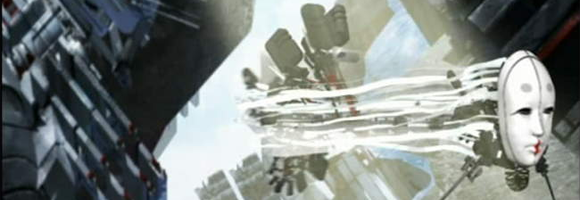To make an alien brain hemorrhage cocktail, fill a shot glass halfway with peach schnapps. Gently pour Bailey’s Irish Cream on top. After the shot is almost full, carefully add a small amount of blue curacao. After it settles, add a few drops of grenadine syrup.
do anthropologists dream of electronic savages?

anthropology, technology, and new worlds
The ‘↑Ethnologische Salon‘ in January
↑Staatliches Museum für Völkerkunde München—Foyer
Friday, 27 January 2012, 19:00h
—‘Do Anthropologists Dream of Electronic Savages?’ lecture by Alexander Knorr, lavishly illustrated by projections
—‘Man and Machine’ Reading from the book ‘↑Cyberanthropology‘ by Alexander Knorr. Read by Karin Sommer and Stefan Eisenhofer
—Independent Short Films:
‘↑World Builder‘ by ↑Bruce Branit (USA 2007)
‘↑Fragile Machine‘ by ↑Ben Steele (USA 2005/2007)
legonaut
Two 17-year-olds from Canada attached a LEGO minifigure to a helium-filled weather ballon and had it soar up 24 km, which is right in the middle of the stratosphere. During the journey upwards the helium inside a balloon expands until the balloon bursts. The legonaut was found 122 km away from the two teenagers’ home—it had safely landed on its homemade parachute. A time lapse camera documented the journey.
technology fundamentally human

↑The Next Web links to the ↑Study: Robots inspire new learning & creativity possibilities for kids (the LEGO Group is involved). Here are The Next Web’s closing paragraphs:
Taking a deeper look at the stories the children created, the survey found that unlike many adults who see technology as separate from humanness, it seems that “kids tend to think of technology as fundamentally human: as a social companion that can entertain, motivate, and empower them in various contexts.”
While this dreamy perspective is partially the result of childhood imagination (something kids from any generation can have), it is clear that kids are eagerly anticipating new ways that tech can enhance their lives.
Sure, it’s easy to dismiss how children look forward to the future and dream without inhibitions, but that’s exactly what some of the greatest innovators of our time have done. Children don’t just react, they imagine, and that’s why this study can’t be overlooked.
Compare that to ↵robotopia nipponica.
mad mex
In India and Pakistan trucks get decorated until they are gaudy pieces of art on wheels:

In Japan the same is done, but there, hardly surprising, the dekotora [decorated trucks] follow the neon æsthetics:

In Sudan trucks are completely deconstructed and then reconstructed—the results are visually not as spectacular as their Asian kin, but are masterpieces of a comparatively young engineering culture (↓Beck 2009):

In Mexico, and within a totally different context, the not so conspicuous Sudanese trucks seem to have cousins: ‘Rhino trucks, narco tanks, Mad Mex-inismos? No one can agree on what to call the armored monster vehicles that Mexican criminal groups have been welding together in recent months, but this much is clear—they are building more of them.’ Thus ↑writes Damien Cave in The New York Times. Here are four specimen:




why the surgery?
zeph’s pop culture quiz #12

Why is surgery performed on this man?
Just leave a comment with your educated guess—you can ask for additional hints, too. [Leaving a comment is easy; just click the ‘Leave a comment’ at the end of the post and fill in the form. If it’s the first time you post a comment, it will be held for moderation. But I am constantly checking, and once I’ve approved a comment, your next ones won’t be held, but published immediately by the system.]
monte cristo jim

This is the islet Montecristo, where Edmond Dantès found the treasure enabling him to become ‘↑The Count of Monte Cristo‘ (↑Dumas 1844-1846) [legally for free ↓at Project Gutenberg] and to take bitter revenge. The photo shows Montecristo as seen from Giglio Island—I took it when I was there in 2007. With all the media coverage of the ↑Costa Concordia disaster I’m astounded that it nowhere crept up that Montecristo was that close (at least I didn’t read it anywhere). The story of the captain (who faces preliminary charges of multiple manslaughter, failure to assist passengers in need, and abandonment of ship) that he by accident fell into the lifeboat, where the First and Second Mate already were, reminded me of another story. With all the speculations around, about Captain Schettino’s failing, his motives and whatyouhave, it is the perfect time to read or reread ↑Joseph Conrad‘s ‘↑Lord Jim‘. (1900) [legally for free ↓at Project Gutenberg]. Here’s a part of Wikipedia’s synopsis:
Jim (his surname is never disclosed), a young British seaman, becomes first mate on the Patna, a ship full of pilgrims travelling to Mecca for the hajj. Jim joins his captain and other crew members in abandoning the ship and its passengers. A few days later, they are picked up by a British ship. However, the Patna and its passengers are later also saved, and the reprehensible actions of the crew are exposed. The other participants evade the judicial court of inquiry, leaving Jim to the court alone. The court strips him of his navigation command certificate for his dereliction of duty. Jim is angry with himself, both for his moment of weakness, and for missing an opportunity to be a ‘hero’.
And here’s an excerpt, the beginning of chapter four:
A month or so afterwards, when Jim, in answer to pointed questions, tried to tell honestly the truth of this experience, he said, speaking of the ship: ‘She went over whatever it was as easy as a snake crawling over a stick.’ The illustration was good: the questions were aiming at facts, and the official Inquiry was being held in the police court of an Eastern port. He stood elevated in the witness-box, with burning cheeks in a cool lofty room: the big framework of punkahs moved gently to and fro high above his head, and from below many eyes were looking at him out of dark faces, out of white faces, out of red faces, out of faces attentive, spellbound, as if all these people sitting in orderly rows upon narrow benches had been enslaved by the fascination of his voice. It was very loud, it rang startling in his own ears, it was the only sound audible in the world, for the terribly distinct questions that extorted his answers seemed to shape themselves in anguish and pain within his breast,—came to him poignant and silent like the terrible questioning of one’s conscience. Outside the court the sun blazed—within was the wind of great punkahs that made you shiver, the shame that made you burn, the attentive eyes whose glance stabbed. The face of the presiding magistrate, clean shaved and impassible, looked at him deadly pale between the red faces of the two nautical assessors. The light of a broad window under the ceiling fell from above on the heads and shoulders of the three men, and they were fiercely distinct in the half-light of the big court-room where the audience seemed composed of staring shadows. They wanted facts. Facts! They demanded facts from him, as if facts could explain anything!
‘After you had concluded you had collided with something floating awash, say a water-logged wreck, you were ordered by your captain to go forward and ascertain if there was any damage done. Did you think it likely from the force of the blow?’ asked the assessor sitting to the left. He had a thin horseshoe beard, salient cheek-bones, and with both elbows on the desk clasped his rugged hands before his face, looking at Jim with thoughtful blue eyes; the other, a heavy, scornful man, thrown back in his seat, his left arm extended full length, drummed delicately with his finger-tips on a blotting-pad: in the middle the magistrate upright in the roomy arm-chair, his head inclined slightly on the shoulder, had his arms crossed on his breast and a few flowers in a glass vase by the side of his inkstand.
‘I did not,’ said Jim. ‘I was told to call no one and to make no noise for fear of creating a panic. I thought the precaution reasonable. I took one of the lamps that were hung under the awnings and went forward. After opening the forepeak hatch I heard splashing in there. I lowered then the lamp the whole drift of its lanyard, and saw that the forepeak was more than half full of water already. I knew then there must be a big hole below the water-line.’ He paused.
‘Yes,’ said the big assessor, with a dreamy smile at the blotting-pad; his fingers played incessantly, touching the paper without noise.
‘I did not think of danger just then. I might have been a little startled: all this happened in such a quiet way and so very suddenly. I knew there was no other bulkhead in the ship but the collision bulkhead separating the forepeak from the forehold. I went back to tell the captain. I came upon the second engineer getting up at the foot of the bridge-ladder: he seemed dazed, and told me he thought his left arm was broken; he had slipped on the top step when getting down while I was forward. He exclaimed, “My God! That rotten bulkhead’ll give way in a minute, and the damned thing will go down under us like a lump of lead.” He pushed me away with his right arm and ran before me up the ladder, shouting as he climbed. His left arm hung by his side. I followed up in time to see the captain rush at him and knock him down flat on his back. He did not strike him again: he stood bending over him and speaking angrily but quite low. I fancy he was asking him why the devil he didn’t go and stop the engines, instead of making a row about it on deck. I heard him say, “Get up! Run! fly!” He swore also. The engineer slid down the starboard ladder and bolted round the skylight to the engine-room companion which was on the port side. He moaned as he ran. . . .’ (Conrad 1900: chpt. 4)
the simple art of murder

There are things which are interesting again and again, forever. ↑Raymond Chandler‘s essay ‘↑The Simple Art of Murder‘ (1950 [1944]) I already have read multiple times, quoted from it in ‘↑Cyberanthropology,’ and so on. Now I just stumbled over it again, via the ↵cyberpunk reading list, where the essay is commented like this:
When reading it, replace ‘mystery novel’ with ‘sci-fi novel’ and its amazing. Every complaint the Cyberpunk authors had about ‘classic sci-fi’ is there as a complaint about ‘classic detective stories.’ – Logan Joshua Ratner
We ↵just had it that William Gibson prefers Dashiell Hammett and is not a fan of Chandler. Well, Chandler himself was a big fan of Hammett—that too shines up brightly in the essay:
Hammett took murder out of the Venetian vase and dropped it into the alley; it doesn’t have to stay there forever, but it was a good idea to begin by getting as far as possible from Emily Post’s idea of how a well-bred debutante gnaws a chicken wing. He wrote at first (and almost to the end) for people with a sharp, aggressive attitude to life. They were not afraid of the seamy side of things; they lived there. Violence did not dismay them; it was right down their street.
Hammett gave murder back to the kind of people that commit it for reasons, not just to provide a corpse; and with the means at hand, not with hand-wrought duelling pistols, curare, and tropical fish. He put these people down on paper as they are, and he made them talk and think in the language they customarily used for these purposes. He had style, but his audience didn’t know it, because it was in a language not supposed to be capable of such refinements. (Chandler 1950 [1944]: 530)
rosa
ROSA is an epic sci-fi short film that takes place in a post-apocalyptic world where all natural life has disappeared. From the destruction awakes Rosa, a cyborg deployed from the Kernel project, mankind’s last attempt to restore the earth’s ecosystem. Rosa will soon learn that she is not the only entity that has awakened and must fight for her survival.
propaganda war games

In ↵manchurian operations club among other things I mused about the detailled historical naturalism of ↑Kuma Reality Games‘ ‘Kuma\War’ [scroll down a bit]. Now those games seem to have generated a dramatic backlash into empirical reality. The ↑Day 6 Documentary: Propaganda Games by the Canadian Broadcasting Corporation:
You don’t have to be a Middle East expert to recognize the relationship between Iran and its western foes has gotten just a wee bit tense.
There’s been sabre rattling military exercises, threats to slow the flow of oil to a trickle, downed drones and uranium enrichment in a highly protected underground bunker.
This week the Iranian government sentenced an Iranian-American to death. Amir Mirza Hekmati was arrested in December. Iran says he’s a spy, and that he was in Iran on an intelligence mission. His mother says he was visiting family.
Shortly after his arrest, Iranian TV and newspapers published what they say is a confession.
It’s impossible for us to know how his confession was extracted.
But in it, Hekmati says he’d worked with a company called Kuma Games – making propaganda video games for the Central Intelligence Agency.
Day 6 first featured Kuma Games ↑last year. At the time they’d just rushed out a video game version of the US raid on the Abbottabad compound that ended with the death of Osama bin Laden.
It’s one of the things they specialize in: video game stories ripped from the headlines.
But could they secretly be CIA propagandists? Day 6 producer Dominic Girard’s documentary tries to make sense of it.


